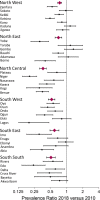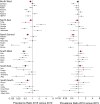Geographical and temporal variation in reduction of malaria infection among children under 5 years of age throughout Nigeria
- PMID: 33632771
- PMCID: PMC7908906
- DOI: 10.1136/bmjgh-2020-004250
Geographical and temporal variation in reduction of malaria infection among children under 5 years of age throughout Nigeria
Abstract
Introduction: Global progress in reducing malaria has stalled since 2015. Analysis of the situation is particularly needed in Nigeria, the country with by far the largest share of the burden, where approximately a quarter of all cases in the world are estimated to occur.
Methods: We analysed data from three nationwide surveys (Malaria Indicator Surveys in 2010 and 2015 and a National Demographic and Health Survey in 2018), with malaria parasite prevalence in children under 5 years of age determined by sampling from all 36 states of Nigeria, and blood slide microscopy performed in the same accredited laboratory for all samples. Changes over time were evaluated by calculating prevalence ratio (PR) values with 95% CIs for each state, together with Mantel-Haenszel-adjusted PRs (PRadj) for each of the six major geopolitical zones of the country.
Results: Between 2010 and 2018, there were significant reductions in parasite prevalence in 25 states, but not in the remaining 11 states. Prevalence decreased most in southern zones of the country (South West PRadj=0.53; South East PRadj=0.59; South South PRadj=0.51) and the North Central zone (PRadj=0.36). Changes in the north were less marked, but were significant and indicated overall reductions by more than 20% (North-West PRadj=0.74; North East PRadj=0.70). Changes in the south occurred mostly between 2010 and 2015, whereas those in the north were more gradual and most continued after 2015. Recent changes were not correlated with survey-reported variation in use of preventive measures.
Conclusion: Reductions in malaria infection in children under 5 have occurred in most individual states in Nigeria since 2010, but substantial geographical variation in the timing and extent indicate challenges to be overcome to enable global malaria reduction.
Keywords: diagnostics and tools; epidemiology; malaria; prevention strategies.
© Author(s) (or their employer(s)) 2021. Re-use permitted under CC BY-NC. No commercial re-use. See rights and permissions. Published by BMJ.
Conflict of interest statement
Competing interests: None declared.
Figures



Similar articles
-
Malaria parasite density and detailed qualitative microscopy enhances large-scale profiling of infection endemicity in Nigeria.Sci Rep. 2023 Jan 28;13(1):1599. doi: 10.1038/s41598-023-27535-1. Sci Rep. 2023. PMID: 36709336 Free PMC article.
-
Folic acid supplementation and malaria susceptibility and severity among people taking antifolate antimalarial drugs in endemic areas.Cochrane Database Syst Rev. 2022 Feb 1;2(2022):CD014217. doi: 10.1002/14651858.CD014217. Cochrane Database Syst Rev. 2022. PMID: 36321557 Free PMC article.
-
Geopolitical zones differentials in intermittent preventive treatment in pregnancy (IPTp) and long lasting insecticidal nets (LLIN) utilization in Nigeria.PLoS One. 2021 Jul 16;16(7):e0254475. doi: 10.1371/journal.pone.0254475. eCollection 2021. PLoS One. 2021. PMID: 34270607 Free PMC article.
-
[Current malaria situation in the Republic of Kazakhstan].Med Parazitol (Mosk). 2001 Jan-Mar;(1):24-33. Med Parazitol (Mosk). 2001. PMID: 11548308 Russian.
-
Preventive malaria treatment among school-aged children in sub-Saharan Africa: a systematic review and meta-analyses.Lancet Glob Health. 2020 Dec;8(12):e1499-e1511. doi: 10.1016/S2214-109X(20)30325-9. Epub 2020 Oct 22. Lancet Glob Health. 2020. PMID: 33222799 Free PMC article.
Cited by
-
Lessons from Nigeria's Adaptation of Global Health Initiatives during the COVID-19 Pandemic.Emerg Infect Dis. 2022 Dec;28(13):S299-S301. doi: 10.3201/eid2813.221175. Emerg Infect Dis. 2022. PMID: 36502443 Free PMC article. Review.
-
Drivers of long-lasting insecticide-treated net utilisation and parasitaemia among under-five children in 13 States with high malaria burden in Nigeria.PLoS One. 2022 May 6;17(5):e0268185. doi: 10.1371/journal.pone.0268185. eCollection 2022. PLoS One. 2022. PMID: 35522617 Free PMC article.
-
Co-morbidity of malaria and soil-transmitted helminths in Nigeria: a joint Bayesian modelling approach.Infect Dis Poverty. 2025 Apr 2;14(1):28. doi: 10.1186/s40249-025-01276-x. Infect Dis Poverty. 2025. PMID: 40170071 Free PMC article.
-
A Bayesian spatio-temporal framework to assess the effect of seasonal malaria chemoprevention on children under 5 years in Cameroon from 2016 to 2021 using routine data.Malar J. 2023 Nov 11;22(1):347. doi: 10.1186/s12936-023-04677-1. Malar J. 2023. PMID: 37951942 Free PMC article.
-
Malaria parasite density and detailed qualitative microscopy enhances large-scale profiling of infection endemicity in Nigeria.Sci Rep. 2023 Jan 28;13(1):1599. doi: 10.1038/s41598-023-27535-1. Sci Rep. 2023. PMID: 36709336 Free PMC article.
References
-
- WHO . World malaria report 2020, 2020. Available: https://www.who.int/publications/i/item/9789240015791
-
- WHO . High burden to high impact: a targeted malaria response. Geneva: World Health Organization, 2019. https://www.who.int/malaria/publications/atoz/high-impact-response/en/
Publication types
MeSH terms
Grants and funding
LinkOut - more resources
Full Text Sources
Other Literature Sources
Medical
Research Materials
